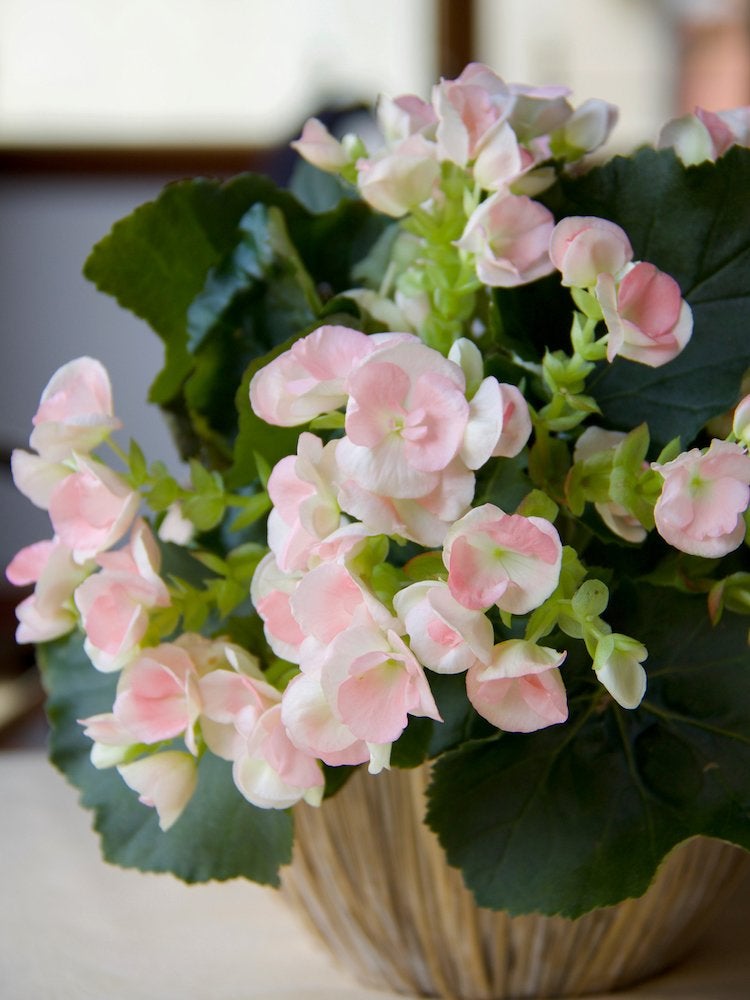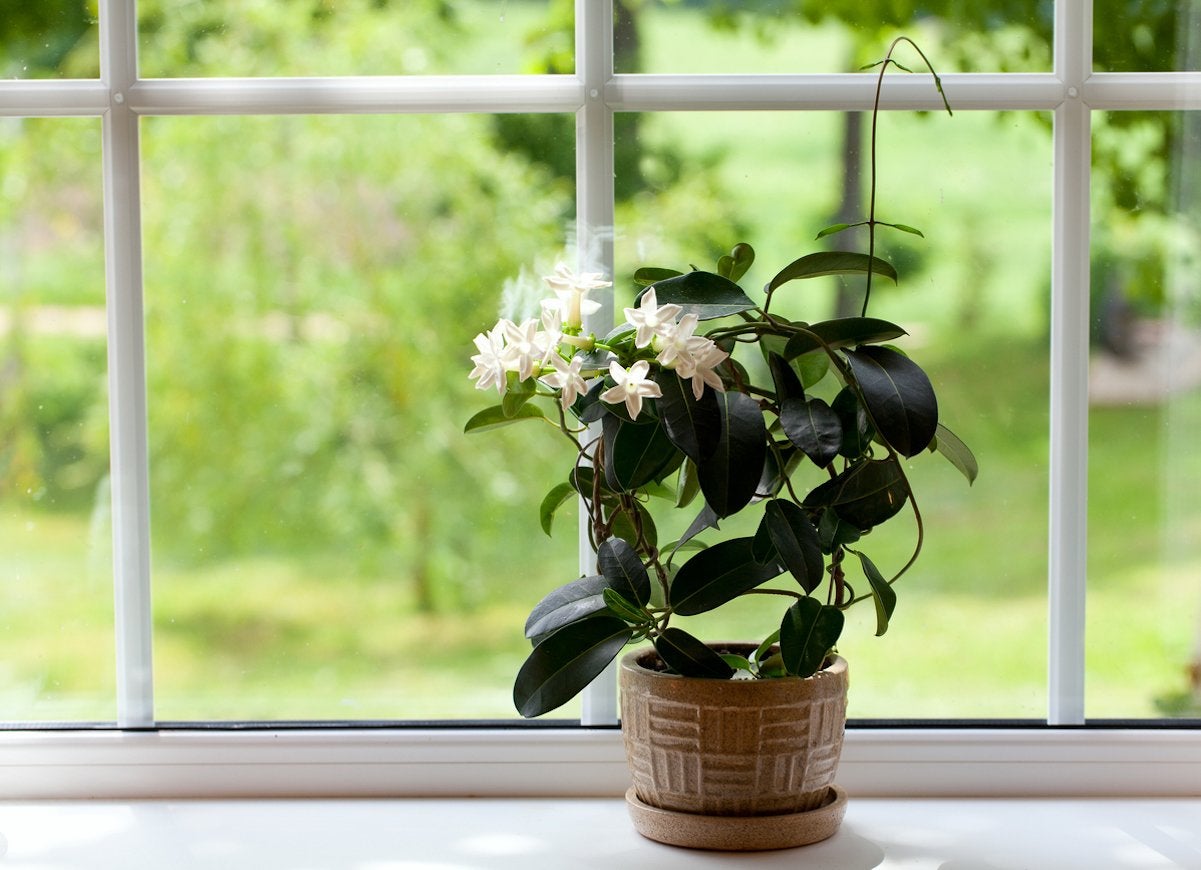We may earn revenue from the products available on this page and participate in affiliate programs. Learn More ›
African Violet

Small in stature but big in wow-factor, the African violet is fairly easy to care for, as flowering houseplants go. Available in hundreds of variations, this fuzzy-leafed houseplant typically blooms year round with blue, purple, or white flowers. Keep this plant slightly root-bound to force more flowers, provide it with partial sunlight, avoid getting the leaves wet, and it can thrive for years.
Begonias

The begonia is a favorite houseplant for many indoor gardeners and it’s not hard to understand why: They require little care and yet reward this sparse attention with colorful flowers. With over 1,000 varieties, there’s a size, color, and shape that’s just right for your home.
Orchid

Orchids get a bad rap for being difficult to keep blooming, but don’t let that scare you from bringing one home. Caring for an orchid gives gardeners a chance to put their green thumbs to the test. Your patience and effort is well worth it for the beautiful flowers on this flowering houseplant.
Related: It’s Not Me, It’s You: The 15 Toughest Houseplants to Keep Alive
Peace Lily

The peace lily is a showstopper, and a remarkably low maintenance one, at that. The large plant has large green leaves and elegant white flowers. When the peace lily’s leaves start to droop you’ll know it’s time for a watering. Peace lilies are toxic to pets, so avoid bringing one home if you have curious cats and dogs, or keep it well out of their reach.
False Shamrock

If you like the color purple then the false shamrock is for you. With its deep plum leaves and dainty violet flowers this colorful houseplant is often mistaken for a shamrock because of the shape of its leaves. The bright color isn’t the only thing that makes the false shamrock stand out among all your houseplants; it is photophilic, meaning its leaves open in daytime to catch the sun’s light, and then close at night.
Bromeliad

Add a touch of the tropics to your home with the exotic bromeliad. The pineapple-shaped plant is surprisingly adaptable to the indoors even though it’s native to the rainforest. While it can be a little tricky to get flowers to bloom, the dramatic pay-off is well worth the effort.
Kalanchoe

The kalanchoe is sometimes referred to as window’s thrill, which makes sense since practically all you need to do is place it in a sunny spot on the windowsill and watch it bloom. This succulent produces tiny flowers no matter the season, and is available in a variety of vibrant colors.
Related: 11 Indoor Gardening Projects Absolutely Anyone Can Do
Amaryllis

The amaryllis blooms in winter when there are almost no signs of life in your outdoor garden beds. Easy to grow in a small pot, you can expect bright, large flowers in shades of red, orange, and pink.
Poinsettia

This holiday favorite is best known for its large crimson leaves, but it also comes in other shades like pink and white. While it is most popular in the month of December, it can be kept year round. One word of caution: This tropical plant hates the cold so keep it away from drafts.
Jasmine

Looking to freshen up a room? Jasmine is a great pick for those who prefer natural air fresheners. Not only does this houseplant produce soft, star-shaped flowers, but it has a strong and sweet fragrance. Place it in a sunny spot away from the cold, and be vigilant for pests or disease.
Chenille

You don’t have to guess why this fuzzy plant is named for the French word for caterpillar. The unique flowers on this evergreen plant makes it a unique choice for hanging over the kitchen sink or in the window of the sitting room.
Kaffir Lily

While a lot of flowering houseplants like full or partial sun, the Kaffir Lily does best in the shade. Expect it to grow quite tall with long, branching leaves. Like all lilies, it’s best to keep this plant away from pets.
Christmas Cactus

Here’s another tropical houseplant with a holiday connection! The trailing Christmas cactus has shiny green leaves that sprout small flowers in pinks or reds. With proper care, you can expect long-lasting blooms during the coldest months.
Anthurium

For many indoor gardeners, the best houseplants are those that make a statement with as little effort as possible. Case in point: the anthurium. A great choice for an otherwise underwhelming corner of the room, it bursts forth with large, heart-shaped flowers all year round.
Crown of Thorns

While you might not suspect it from its floppy leaves and delicate flowers, the crown of thorns is a hardy succulent. Adaptable to indoor conditions, the plant can survive a missed watering or two. Be careful when handling the plant because, as the name implies, it has thorns all along the stem.
Gloxinia

With its fluffy flowers and velvety leaves, Gloxina offers a lot of texture. Available in many bold shades, some varieties of this flowering houseplant have marbled or multi-colored blooms.
Ixora

With clusters of small flowers, the Ixora adds a burst of color in any home. With adequate sunlight and acidic potting soil, this brightly colored shrub will bloom all year long.
Geranium

Geraniums are a classic houseplant—and for good reason! The fragrant flowers come in an abundance of colors and bloom almost year round. Geraniums need only occasional watering and sunlight to add abundant beauty to your home.
Related: Count On These 25 Indoor Plants for Easy Color Year-Round
Cyclamen

Pretty in pink, and red, and white, this flowering houseplant can be fussy but is well worth the gardening challenge. In addition to the small plant’s unusually shaped blooms, it has leaves marked with silvery patterns. Water the plant when the soil feels dry, provide it bright indirect light, and keep it in a room that is neither too hot nor too cold.
Calathea Crocata

If you think the calathea crocata resembles a torch, you aren’t alone; its common name is eternal flame. The easy-care plant blooms with flared orange flowers, adding a touch of the tropics to an ordinary living room.

Our Best Advice for Beginner Gardeners
We’ll help you set up your first garden—whether that’s a few pots on your patio, a raised bed, or an in-ground plot out back—and select the right plants for your soil and region.

